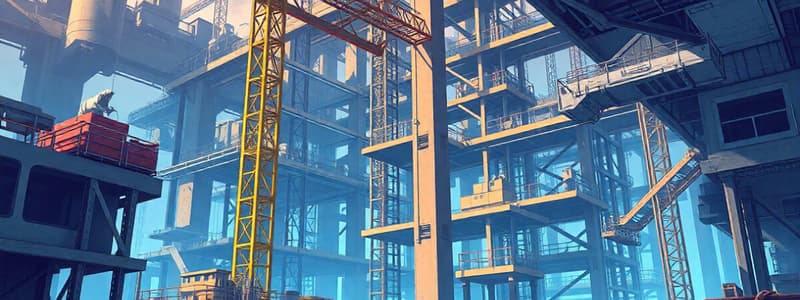Podcast
Questions and Answers
Name two kinds of different piles.
Name two kinds of different piles.
Displacement Pile(Steel-H piles), Replacement Pile(Barrettes)
What is the advantage of using Tremie pipes?
What is the advantage of using Tremie pipes?
to prevent concrete contamination
Suppose we have three formworks: column, slab and beams. Which formwork could be removed first/earlier?
Suppose we have three formworks: column, slab and beams. Which formwork could be removed first/earlier?
Wall and Columns (because it can stand on his own)
How long does it take to remove these three formworks (column, slab and beams)?
How long does it take to remove these three formworks (column, slab and beams)?
What kind of pump can be used in dewatering?
What kind of pump can be used in dewatering?
What is self-compacting concrete?
What is self-compacting concrete?
What materials is added into the concrete so that it could become self-compacting?
What materials is added into the concrete so that it could become self-compacting?
Suppose you have a super tall building; what kind of formwork is used for the slab construction, which could speed up the construction?
Suppose you have a super tall building; what kind of formwork is used for the slab construction, which could speed up the construction?
What are the main steels for the Continuous Beam?
What are the main steels for the Continuous Beam?
What are the main steels for the Simply Supported Beam?
What are the main steels for the Simply Supported Beam?
As there will be joint problems with precast structures, which joint is better for improving water tightness?
As there will be joint problems with precast structures, which joint is better for improving water tightness?
Which construction equipment is more silent?
Which construction equipment is more silent?
What is the critical temperature of a structure that will lose half its strength in a fire?
What is the critical temperature of a structure that will lose half its strength in a fire?
Suppose in construction site, I want to move the wall tile of sinks from ground elevation to the fifth floor. What construction machines or plant should use to pick up this wall tile?
Suppose in construction site, I want to move the wall tile of sinks from ground elevation to the fifth floor. What construction machines or plant should use to pick up this wall tile?
We got two kinds of materials, epoxy and silicone. Which one is suitable for water tightness jointing?
We got two kinds of materials, epoxy and silicone. Which one is suitable for water tightness jointing?
What materials should be used in the cover spaces?
What materials should be used in the cover spaces?
There are three types of systems in curtain wall, which one is the most famous one?
There are three types of systems in curtain wall, which one is the most famous one?
Which one is the most popular displacement pile in HK?
Which one is the most popular displacement pile in HK?
What is the machine for bored pile installation?
What is the machine for bored pile installation?
What are Common Pile Tests?
What are Common Pile Tests?
What are the advantages of the top-down method?
What are the advantages of the top-down method?
For deep basements, what methods should be used depending on the depth?
For deep basements, what methods should be used depending on the depth?
What is the potential Risk for building basement?
What is the potential Risk for building basement?
What are the advantages of precast concrete?
What are the advantages of precast concrete?
Once the site had adopted prefabrication, what are the important considerations for prefabrication on site plan?
Once the site had adopted prefabrication, what are the important considerations for prefabrication on site plan?
Flashcards
Displacement Pile
Displacement Pile
A pile that is driven into the ground and displaces the soil as it is driven down.
Replacement Pile
Replacement Pile
A pile that is drilled into the ground and replaces the soil that was removed.
Steel-H Pile
Steel-H Pile
A type of pile made from steel, often used in displacement pile foundations.
Barrettes
Barrettes
Signup and view all the flashcards
Tremie Pipe
Tremie Pipe
Signup and view all the flashcards
Self-compacting Concrete
Self-compacting Concrete
Signup and view all the flashcards
Superplasticizer
Superplasticizer
Signup and view all the flashcards
Submerged Pump
Submerged Pump
Signup and view all the flashcards
Suction Pump
Suction Pump
Signup and view all the flashcards
Dewatering
Dewatering
Signup and view all the flashcards
Formwork
Formwork
Signup and view all the flashcards
Column Formwork
Column Formwork
Signup and view all the flashcards
Slab Formwork
Slab Formwork
Signup and view all the flashcards
Beam Formwork
Beam Formwork
Signup and view all the flashcards
Fly Form/Table Form
Fly Form/Table Form
Signup and view all the flashcards
Top Steel (cantilever) and Bottom Steel (Span)
Top Steel (cantilever) and Bottom Steel (Span)
Signup and view all the flashcards
Bottom Steel
Bottom Steel
Signup and view all the flashcards
Top Steel (Over Column)
Top Steel (Over Column)
Signup and view all the flashcards
Precast Joining
Precast Joining
Signup and view all the flashcards
Wet Joint
Wet Joint
Signup and view all the flashcards
Dry Joint
Dry Joint
Signup and view all the flashcards
Hydraulic Vibrator Machine
Hydraulic Vibrator Machine
Signup and view all the flashcards
Critical Temperature
Critical Temperature
Signup and view all the flashcards
Material Hoist
Material Hoist
Signup and view all the flashcards
Epoxy
Epoxy
Signup and view all the flashcards
Silicone
Silicone
Signup and view all the flashcards
Cover
Cover
Signup and view all the flashcards
Curtain Wall
Curtain Wall
Signup and view all the flashcards
Unitised System
Unitised System
Signup and view all the flashcards
Top-Down Method
Top-Down Method
Signup and view all the flashcards
Bottom Up Method
Bottom Up Method
Signup and view all the flashcards
Diaphragm Wall
Diaphragm Wall
Signup and view all the flashcards
Steel Sheet Piling
Steel Sheet Piling
Signup and view all the flashcards
Cofferdam
Cofferdam
Signup and view all the flashcards
Study Notes
Pile Types
- Two types of piles exist: displacement piles (e.g., steel H piles) and replacement piles (e.g., barrettes).
Tremie Pipes
- Tremie pipes are used to prevent concrete contamination during placement.
Formwork Removal Priority
- Walls and columns can be removed first as they can support themselves.
- Beams and slabs need to be supported, so they are removed later.
- Wall formwork removal takes around 24 hours.
- Beam and slab formwork removal takes approximately 2 weeks
Dewatering Pumps
- Submerged pumps and suction pumps can be used for dewatering.
Self-Compacting Concrete
- Self-compacting concrete is highly workable and pumpable.
- Superplasticizer is added to achieve these properties.
Formwork for Tall Buildings
- Fly form and table form are used for speeding up slab construction in very tall buildings.
Steel Reinforcement in Beams
- Continuous beams use top and bottom steel (including cantilever sections) and top steel over columns.
- Simply supported beams only use bottom steel.
Joint Problems in Precast Construction
- Wet joints (monolithic joints) are better than dry joints (using gaskets/sealants). This is because in-situ topping concrete filling gaps eliminates the need for unreliable seals.
Silent Construction Equipment
- Hydraulic vibrator machines are known for their quiet operation.
Structural Damage from Fire
- Steel and concrete structures lose half their strength at 600°C.
Materials Handling for Wall Tiles
- Material hoists are used to move wall tiles from ground level to higher floors.
Water Tightness Sealants
- Silicone is the most effective sealant for water tightness.
- Epoxy is for issues such as concrete spalling repair.
Cover Spacers
- Plastic spacers are typically used in formwork to support rebar and keep it in place.
Curtain Wall System
- Unitised curtain wall systems are most common, due to their effectiveness and cost-efficiency.
Bored Pile Installation Machines
- Bored pile installation uses temporary steel casing, hydraulic oscillator, chisel, and RCD with roller bits.
Common Pile Tests
- Common pile tests include dynamic load tests, static load tests, sonic logging tests, standard penetration tests, core drilling, vibration testing, lateral load tests, and tension tests.
Top-Down Construction Advantages
-
Top-down methods reduce construction time by allowing basement and superstructure construction simultaneously.
-
They also allow for weather-tight working conditions.
Deep Basement Construction Methods
- Diaphragm walls and top-down methods are used for deep basements (over 20m).
- Steel sheet piling and cofferdams are used for shallower basements (10-20m).
Basement Construction Risks
- Basement construction risks include soil collapse, worker safety, underground utility disruption, neighboring building foundation issues, and ground water/flooding.
Precast Concrete Advantages
-
Precast concrete is more consistent in quality due to factory controls.
-
It often uses semi-skilled workers, which reduces labor cost.
-
Indoor factory production of components means protection from inclement weather.
-
Robots aid consistency, and pre-assembly offers better compaction.
Precast Concrete Considerations
- Windows should be cast before concrete pouring for less water leakage risk and waterproofing layers are used on the floor slab.
Precast Construction Benefits
- Reduced construction times, weather-independent operations, and higher productivity.
- Fewer different trades reduce possible conflicts, and formwork use is reduced.
- Factory-produced components minimize onsite material wastage and reduce noise/air pollution.
Prefabrication Site Plan Considerations
- Consider the tower crane's capacity and reach to ensure it can handle the materials.
- The area for storing prefabricated materials should match daily consumption rates.
- Design adequate internal access to allow for materials delivery and worker or machine movement.
Studying That Suits You
Use AI to generate personalized quizzes and flashcards to suit your learning preferences.




